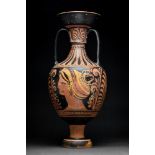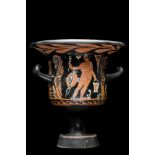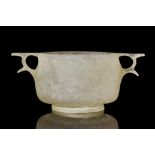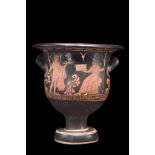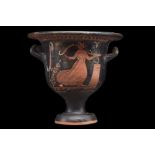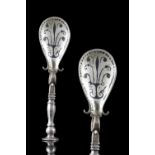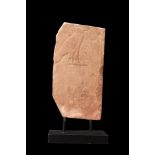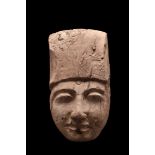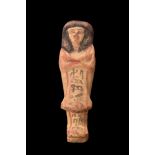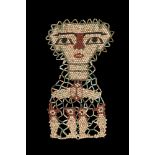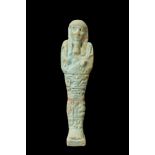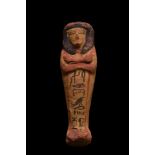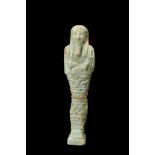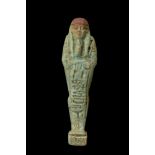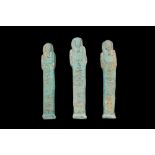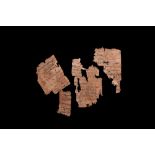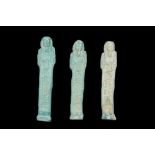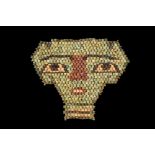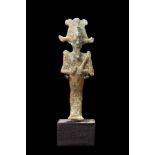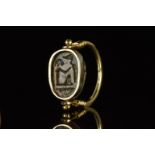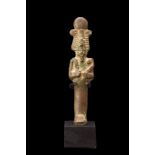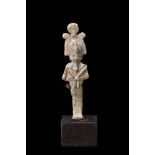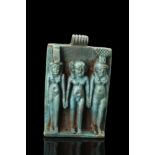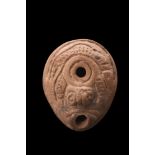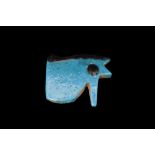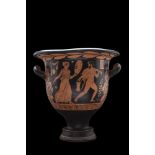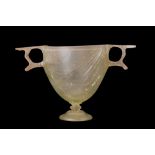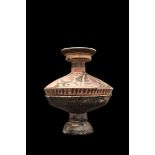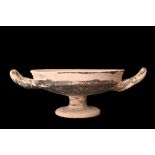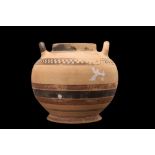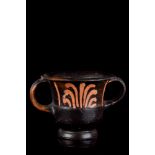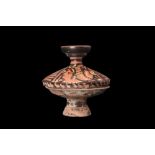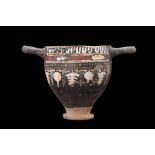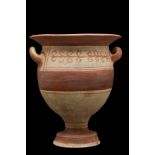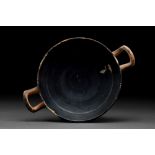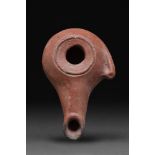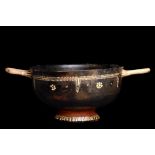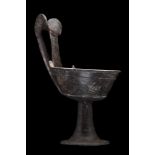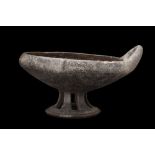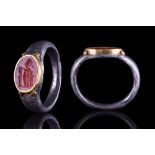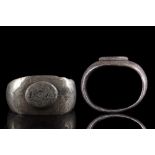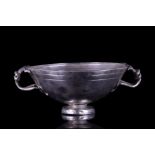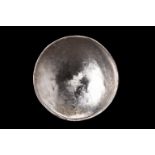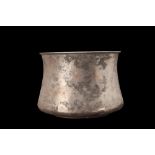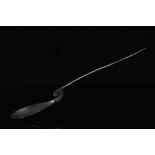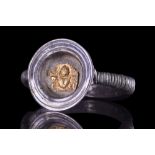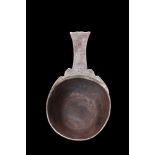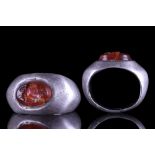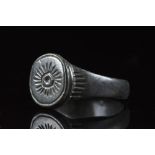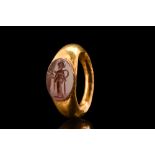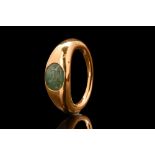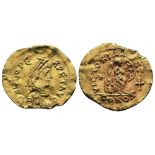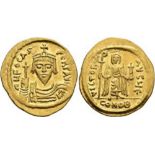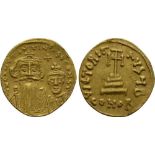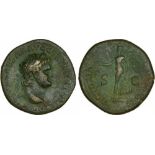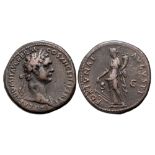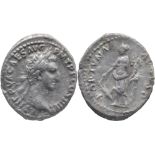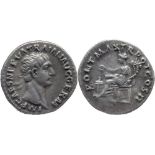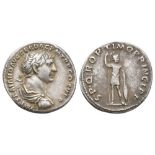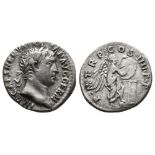Filtered by:
- Category
- List
- Grid
A subscription to the Price Guide is required to view results for auctions ten days or older. Click here for more information
Ca. 320 AD. A huge and beautiful red figure Apulian amphora. On one side is a seated, a flowering plant in an Ionic naiskos, a small temple often ...
Ca. 430-300 BC. A beautiful terracotta bell krater features a pedestal foot, cylindrical flared stem, inverted bell-shaped body, two upturned hand...
RARE GREEK CUT GLASS SKYPHOS
Greece, late 2nd - early 1st century BC. A Greek skyphos is a marvel of ancient craftsmanship, a vessel that embodies the beauty and elegance of H...
Ca. 350-300 BC. An exquisite Apulian bell krater with its surface area painted via the red-figure technique with added fugitive yellow pigment. Si...
Ca. 350-300 BC. The krater with disc foot, short stem, bulbous body and flaring lip, two ribbon-like handles are set bilaterally, beneath the rim ...
Ca. 200-300 AD. A rare silver spoon featuring a pear-shaped bowl adorned with a beautiful niello design. The handle is baluster-moulded and has tw...
Old Kingdom, ca 2300 BC. A sandstone relief section of the sub-rectangular form, carved in raised relief with the bust of an offering bearer in pr...
Late Dynastic Period, Ca. 664-332 BC. Late Dynastic Period, Ca. 664-32 BC. A carved sarcophagus mask formed from a finely-grained cedar wood. The ...
New Kingdom, 19th - 20th Dynasty, ca. 1292-1085 BC. A well-moulded terracotta ushabti, wearing the tripartite wig, holding hoe and mattock, basket...
Late Period, Ca. 664-332 BC. A mummy shroud composed of threaded faience beads arranged in a net pattern, which collectively form a remarkably det...
Late Period, Ca. 664-332 BC. A blue faience ushabti. The mummiform figurine wears a tripartite wig, his crossed hands hold hoes, and a seed bag ha...
New Kingdom, 19th - 20th Dynasty, Ca. 1292-1085 BC. A well-moulded terracotta ushabti, wearing the tripartite wig, holding hoe and mattock, basket...
Late Period, Ca. 664-332 BC. A mummiform figure in the form of an ushabti, moulded in a light-blue, glazed faience, wearing a tripartite wig and d...
Ca. 664-525 BC. A funerary statuette with a mummy-shaped body and back pillar standing on a small base plate. Modelled details, wearing a triparti...
Late Period, 30th Dynasty, Ca. 332 BC. A group of three light blue faience ushabti figures, each wearing a tripartite wig, a false beard, and with...
Roman Period, Ca. 31 BC. A fragment of papyrus inscribed with demotic cursive script. Demotic was the fourth phase of the Egyptian language, used ...
Late Period, 30th Dynasty, Ca. 332 BC. A group of three ushabti figures, each moulded in a light-blue, glazed faience, wearing a tripartite wig an...
EGYPTIAN FAIENCE MUMMY MASK
Late Period, ca. 663-323 BC. A beaded mummy mask made of delicate faience beads in green, cream, red, and black. The face is highly stylised with ...
EGYPTIAN BRONZE OSIRIS
Late Dynastic Period, ca. 664-332 BC. A bronze figurine depicting upright Osiris wearing an Atef crown, plumed on each side with ostrich feathers ...
Ca. 1570-1070 BC. A finely modelled swivel ring featuring a gold bezel incorporating a glazed composition scarab inscribed to the underside. The r...
EGYPTIAN BRONZE OSIRIS
Late Dynastic Period, ca. 664-332 BC. A bronze figure of Osiris in mummiform position holding the crook and flail. He is depicted with a braided d...
EGYPTIAN BRONZE OSIRIS
Late Dynastic Period, ca. 664-332 BC. A bronze figure of God Osiris shown mummiform with a braided divine beard curved out at its tip, an atef-cro...
Late Period, ca. 700-30 BC. A glazed composition amulet featuring a relief triad of Horus, Isis, and Nepthys. The amulet is rectangular in shape w...
Ca. 200-300 AD. A terracotta oil lamp of a teardrop shape, with a small spout and a central recess for filling oil. The main body of the lamp is f...
Third Intermediate Period, ca. 1069-702 BC. A glazed composition wedjat amulet depicted with a black brow, and pupil creating a stark contrast wit...
Ca. 400-300 BC. A beautiful red-figure terracotta krater with a broad rim, bell-shaped body flanked by two lug handles, and a pedestalled ring foo...
Ca. 200 BC. An elegant glass skyphos consisting of a deep cup supported by a pedestal foot, with two opposing handles adorning its sides. The pale...
Ca. 340-325 BC. A ceramic lekanis of the red-figure lid with two female profile heads between palmettes and stylised volutes. The "Ladies of Fashi...
GREEK ATTIC POTTERY KYLIX
Ca. 500 BC. A terracotta kylix with a hemispherical bowl, short pedestal foot, and two equally spaced loop handles. Decorated in a characteristic ...
MESSAPIAN POTTERY LEBES GAMIKOS
Ca. 400-300 BC. A terracotta lebes gamikos, a delicately formed "marriage vase" with an inverted bell-shaped body and its characteristic pair of h...
Apulia, Ca. 2nd half of the 4th Century BC. An attractive miniature kantharos, a deep, slightly waisted cup on a disc foot with two, opposing stra...
Ca. 340-325 BC. A terracotta red-figure lekanis consisting of a black-glazed footed dish with a flange to receive the lid that is elaborately deco...
Ca. 375-300 BC. This skyphos is a particularly nice and well-preserved example of a typical drinking cup from Southern Italy in the highly decorat...
Ca. 350-300 BC. A finely modelled Daunian pottery krater with a large, rounded body, a broad funnel rim, and twin upraised handles, all upon a fla...
GREEK ATTIC BLACKWARE KYLIX
Ca. 400 BC. A stemless terracotta Greek kylix (drinking cup), covered in a black gloss. The large, shallow body rests on a low foot that concaves,...
HELLENISTIC TERRACOTTA OIL LAMP
Ca. 1st century BC - 1st century AD. A terracotta oil lamp with a round upper body with inward-sloping discus and a filling hole. The long nozzle ...
GNATHIAN DECORATED SKYPHOS
Apulia, southern Italy, ca. 375–300 BC. A beautiful skyphos on a low ring foot, gently sloping body and ear-shaped horizontal handles. The foot is...
ETRUSCAN BUCCHERO KANTHAROS
Ca. 550-500 BC. A large bucchero, blackware Kantharos from Etruria featuring a high flaring foot, a ridged stem, with bands of incised linear dec...
VILLANOVAN IMPASTO KYATHOS
Northern Italy, Villanovan culture, ca. 800-700 BC. A black kyathos, a single-handled dipper with an interestingly-shaped conical foot of openwork...
Ca. 100-300 AD. A stunning silver ring of a round, flat-section hoop and a gilded bezel setting embellished with four corner knobs. It is set with...
Ca. 100-300 AD. A Roman silver ring of Henig type X with its characteristic broad shoulders tapering to the rear. The flat bezel is set with an ov...
Ca. 200 AD. A silver kylix with a hemispherical bowl resting on a concave foot and two equally spaced loop handles. Decorated on the exterior with...
ROMAN SILVER PLATE
Ca. 100-200 AD. A silver shallow bowl with its walls flaring elegantly towards a wide opening, creating a sense of depth and volume that is both v...
Ca. 100-300 AD. A stunning silver vessel with a deep basin, a flat base, smooth corseted walls, and a wide opening with an everted rim. Crafted wi...
ROMAN SILVER COCHLEAR SPOON
Ca. 100-300 AD. A solid silver spoon with a wide bowl attached to a long round-section handle finished with a pointed finial for use in extracting...
Ca. 100-200 AD. A magnificent silver bracelet composed of a smooth and tapering shank, coiled wire around the shoulders, and an affixed circular r...
ROMAN SILVER PATERA
Ca. 1st century AD. A beautiful silver patera comprising a deep body with gently sloping sides, a rounded rim, and a protruding, flaring handle te...
Ca. 100-300 AD. A silver finger ring, Hening type X with its characteristic bulbous design. The ring is set with carnelian intaglio depicting a sc...
Ca. 200-500 AD. A bronze finger ring with a circular loop, and a slightly raised round bezel bearing an incised decoration comprising a sun motif ...
Ca. 100-300 AD. A red stone intaglio engraved with a standing figure of Minerva (Greek Athena), the goddess of wisdom and warfare. She stands robe...
Ca. 100-300 AD. A green jasper intaglio engraved with a seated and winged figure, facing left, and holding a laurel wreath in his right hand. The ...
LEO I AV. SEMISSIS
AD 462 or 466. Leo I Av. semissis, AD 462 or 466, Constantinople mint. DN LEO PE-RPET AVG; pearl diademed, draped, cuirassed bust right. Rev. VICT...
PHOCAS AV. SOLIDUS
AD 602-610. Phocas Av. solidus, AD 602-610, Constantinople mint. Struck AD 607-610. ? N FOCAS PERP AVI; draped and cuirassed bust of Phocas facing...
CONSTANS II AV. SOLIDUS
AD 641-668. Constans II with Constantine IV Av. solidus, AD 641-668, Constantinople mint. ? N CONSTATIN?S C CO?ST; crowned and draped facing busts...
NERO AE. DUPONDIUS
AD 64. Nero Ae. dupondius, AD 64, Lyon. NERO CLAVD CAESAR AVG GER P M TR P IMP P P; laureate head right. Rev. VICTORIA - AVGVSTI/ S|C// II; Victor...
DOMITIAN AE. AS
AD 86. Domitian Ae. as, AD 86, Rome. IMP CAES DOMIT AVG GERM COS XII CENS PER P P; laureate bust to right, wearing aegis. Rev. FORTVNAE AVGVSTI; F...
NERVA AR. DENARIUS
Ca. AD 96-98. Nerva Ar. denarius, ca. AD 96-98, Rome. IMP NERVA CAES AVG P M TR P COS II P P; Laureate head right. Rev. FORTVNA AVGVST; Fortuna st...
TRAJAN AR. DENARIUS
Ca. AD 98-117. Trajan Ar. denarius, ca. AD 98-117, Rome. IMP CAES NERVA TRAIAN AVG GERM; laureate head right. Rev. PONT MAX TR POT COS II; Abundan...
TRAJAN AR. DENARIUS
AD 98-117. Trajan Ar. denarius, AD 98-117, Rome. IMP TRAIANO AVG GER DAC P M TR P COS V P P; Laureate, draped and cuirassed bust of Trajan right. ...
TRAJAN AR. DENARIUS
AD 98-117. Trajan Ar. denarius, AD 98-117, Rome. IMP CAES NERVA TRAIAN AVG GERM; Laureate head of Trajan, right. Rev. PM TRP COS IIII PP; Victoria...

